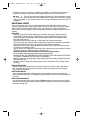
7
• To switch the tool off, release the variable speed switch. To switch the tool off when in
continuous operation, press the variable speed switch once more and release it.
The drill should only be locked ON when it is held stationary in a drill
press stand or other means; NOT BY HAND! Never unplug the tool with the locking
feature engaged. To do so will cause the tool to start immediately the next time it is
plugged in.
REVERSING LEVER
The reversing lever (3) is used for withdrawing bits from tight holes and removing
screws. It is located above the trigger switch. To reverse the motor, release the trigger
switch FIRST and then push the lever to the right. After any reversing operations,
return lever to forward position. Never change the direction of rotation while the motor is
running.
DRILLING
• Always unplug the drill when attaching or removing accessories. When attaching
accessories in the drill chuck, it is important to securely tighten the chuck using all
three holes to prevent slippage. When using a keyless chuck, hand tighten firmly.
• Use sharp drill bits only.
• Support and secure work properly, as instructed in the Safety Instructions.
• Use appropriate and required safety equipment, as instructed in the safety instructions.
• Secure and maintain work area, as instructed in the safety instructions.
• Run the drill very slowly, using light pressure, until the hole is started enough to keep
the drill bit from slipping out of it.
• Apply pressure in a straight line with the bit. Use enough pressure to keep the bit biting
but not so much as to stall the motor or deflect the bit.
• Hold the drill firmly with both hands to control its twisting action.
• Drills equipped with a side handle must use the side handle.
• DO NOT CLICK THE TRIGGER OF A STALLED DRILL OFF AND ON IN AN ATTEMPT
TO START IT. DAMAGE TO THE DRILL CAN RESULT.
• Minimize stalling on breakthrough by reducing pressure and slowly drilling through the
last part of the hole.
• Keep the motor running while pulling the bit out of a drilled hole. This will help reduce
jamming.
DRILLING IN WOOD
Holes in wood can be made with the same twist drill bits used for metal or with spade
bits. These bits should be sharp and should be pulled out frequently when drilling to
clear chips from the flutes.
DRILLING IN METAL
Use a cutting lubricant when drilling metals. The exceptions are cast iron and brass
which should be drilled dry. The cutting lubricants that work best are sulfurized cutting oil
or lard oil.
DRILLING IN MASONRY
Use carbide tipped masonry bits. Refer to
Drilling
section. Keep even force on the drill
but not so much that you crack the brittle material. A smooth, even flow of dust indicates
the proper drilling rate.
:
90538674 PC600D Drill 10/1/08 9:24 AM Page 7


















